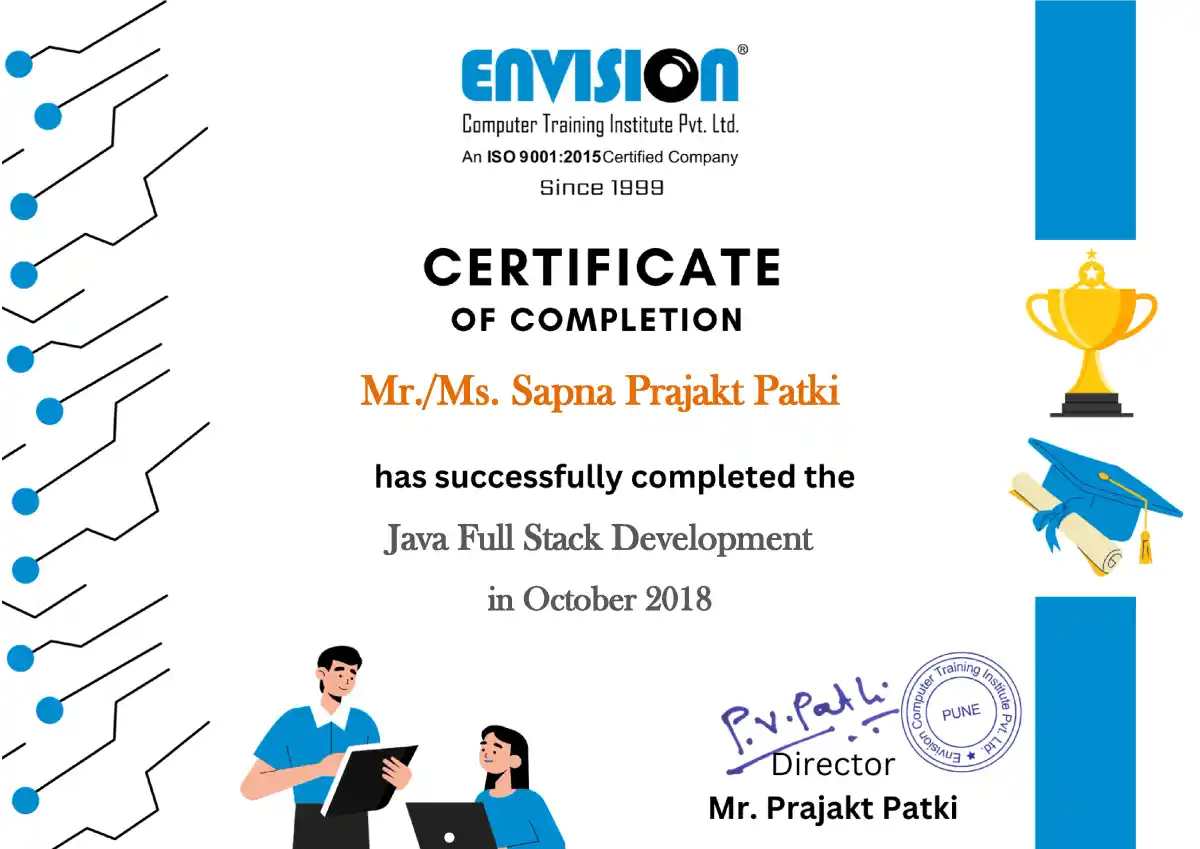Javascript fundamentals part 1
JavaScript is a powerful programming language that is widely used for developing interactive web
applications. In this paragraph, we will briefly touch upon various topics related to JavaScript. In
JavaScript, we start with the classic "Hello, World!" example to introduce the language. It's a
simple yet essential starting point for any programming journey. Full stack java course in pune. We
then move on to discuss the basics of JavaScript, including an overview of the language and its
syntax. We explore how to link JavaScript files to HTML documents, allowing us to incorporate
JavaScript functionality into web pages. Values and variables are fundamental concepts in
JavaScript. We delve into data types such as numbers, strings, Booleans, and more. We also cover the
different ways of declaring variables using let, const, and var. Basic operators like arithmetic,
assignment, comparison, and logical operators are crucial for performing computations and making
decisions in JavaScript. We explore their usage and importance. Strings and template literals play a
significant role in JavaScript for handling text and generating dynamic content. We discuss their
features and demonstrate how to work with them effectively. Taking decisions is a crucial part of
any programming language. JavaScript provides the if/else statement for conditional execution based
on certain conditions. Type conversion allows us to convert values from one data type to another. We
explore various methods and scenarios for type conversion in JavaScript. JavaScript has truth and
false values that determine the truthiness or falseness of a given expression. Understanding these
concepts is vital for logical operations and conditional statements. Equality operators, such as ==,
===, !=, !==, ??, and ??=, are used to compare values and determine equality in JavaScript. Boolean
logic plays a crucial role in programming, and JavaScript provides logical operators like &&, ||,
and ! for combining and negating conditions. The switch statement provides an elegant way to execute
different code blocks based on different cases or conditions. In java full stack developer course in
pune in JavaScript, we differentiate between statements and expressions, understanding their
differences and how they are used in different contexts. Lastly, we explore the conditional
(ternary) operator, which allows us to write concise and compact conditional expressions. These
topics provide a brief overview of key concepts and features in JavaScript. As you delve deeper into
JavaScript development, you will encounter more advanced concepts and techniques that will enable
you to build robust and interactive web applications.
Javascript Fundamentals part 2
In JavaScript, there are several additional topics that are important to understand in order to
enhance your programming skills. Let's explore these topics briefly. Activating strict mode is an
important step to ensure better code quality and prevent common errors. It enables a stricter set of
rules for JavaScript code, helping to catch mistakes and enforce good coding practices. Java full
course, Functions are a fundamental concept in JavaScript. They allow you to encapsulate reusable
blocks of code and execute them whenever needed. We discuss function declarations and function
expressions, highlighting their differences and best practices. Arrow functions provide a concise
syntax for writing functions in JavaScript. They offer a more streamlined way to define functions,
especially for simple one-liners or when using functions as arguments. Arrays are powerful data
structures in JavaScript. We explore basic array operations and methods that allow you to manipulate
arrays efficiently, such as adding or removing elements, accessing values, and iterating over
arrays. Objects are key components in JavaScript. They allow you to represent complex data
structures and store related information. We introduce the basics of objects, including object
properties and methods, and demonstrate how to work with them. Iteration is a fundamental concept in
programming, and JavaScript provides the `for` loop as a common way to iterate over a specific
number of times. We discuss how to use the `for` loop effectively and highlight its syntax. Looping
arrays is a common task in JavaScript. We explore how to iterate over arrays using the `for` loop
and discuss techniques for breaking out of a loop or skipping to the next iteration. Full stack java
developer course in pune sometimes, it's necessary to loop backwards through an array or use loops
within loops. We explore these scenarios and provide examples to help you understand and implement
such loops effectively. The `while` loop provides an alternative way to iterate as long as a certain
condition is true. We discuss the syntax and provide examples of how to use the `while` loop in
JavaScript. Understanding these additional JavaScript topics expands your programming capabilities
and allows you to write more efficient and sophisticated code. As you gain more experience, you'll
discover additional concepts and techniques that further enhance your JavaScript skills.
Javascript Dom and Dom manipulations
The Document Object Model (DOM) is a programming interface that represents the structure of an HTML
or XML document as a tree-like structure. It provides a way to interact with and manipulate the
content, structure, and style of web pages. DOM manipulation involves accessing and modifying
elements in the DOM tree using JavaScript. Java full stack developer course with the help of various
DOM methods and properties, we can select elements by their IDs, classes, or tags and perform
operations such as changing their content, attributes, or styles. Handling click events is a common
requirement in web development. JavaScript allows us to listen for click events on specific elements
and define functions that execute when the click event occurs. This enables us to create interactive
and dynamic behavior on our web pages. Manipulating CSS styles dynamically is another powerful
feature of JavaScript. By accessing an element's style property, we can modify its CSS properties,
such as changing the color, font size, or position. This enables us to create dynamic and visually
appealing web pages. Working with classes is important for styling and organizing elements.
JavaScript provides methods to add, remove, or toggle classes on elements, allowing us to change
their appearance or behavior based on certain conditions or user interactions. Handling various
events goes beyond just click events. JavaScript provides a wide range of events, such as mouse
over, key down, submit, and more. By listening to these events, we can trigger specific actions or
behaviors in response to user interactions, creating dynamic and engaging web experiences.
Understanding the DOM and mastering DOM manipulation techniques, event handling, and CSS
manipulation empowers developers to create dynamic, interactive, and responsive web pages. By
leveraging these capabilities, we can enhance user experiences and build rich web applications.
Javascript Fundamentals part 3
Looping Arrays using normal loops, map, filter, array/object destructuring allows us to iterate
over arrays and perform various operations on their elements. Full stack java developer course with
normal loops like for or while, we can iterate through each element and perform custom actions or
transformations. Map and filter are higher-order array methods that provide a more concise and
functional approach to looping. Map allows us to create a new array by applying a transformation
function to each element, while filter creates a new array by filtering out elements based on a
condition. Array and object destructuring enables us to extract values from arrays or objects and
assign them to variables, making it easier to work with individual elements. Creating DOM elements
dynamically is a common task in web development full course. With JavaScript, we can
programmatically create HTML elements, set their attributes and content, and append them to the DOM.
This allows us to dynamically generate and modify the structure of our web pages based on user
interactions or data. Math, Date, String, and Array functions are built-in JavaScript functions that
provide various operations and utilities for working with numbers, dates, strings, and arrays. These
functions allow us to perform calculations, manipulate dates and times, manipulate strings, and
perform array-specific operations such as sorting, searching, and merging. Set Timeout and set
Interval are functions that allow us to schedule the execution of code after a certain delay or at
regular intervals, respectively. This is useful for implementing timed actions, animations, or
periodic updates on web pages. Event listeners are an essential part of interactive web development.
By attaching event listeners to DOM elements, we can listen for specific events such as clicks,
mouse movements, keyboard inputs, and more. When the specified event occurs, the associated function
is executed, allowing us to respond to user actions and create dynamic and interactive behaviors on
our web pages.
Javascript Ajax (HTTP requests)
Working with Axios and fetch HTTP request are both JavaScript libraries used for making HTTP
requests from client-side applications. In full stack web dev course, Axios is a popular HTTP client
library that provides an easy-to-use API for making AJAX requests. It supports various request
methods like GET, POST, PUT, DELETE, and more. With Axios, we can send HTTP requests to servers and
handle the response data in a convenient manner. It also supports features like request headers,
query parameters, request cancellation, and error handling. On the other hand, fetch is a built-in
JavaScript API for making HTTP requests. It provides a simpler and more modern interface compared to
older approaches like XML Http Request. Fetch uses promises to handle asynchronous operations,
making it easier to work with and providing a more intuitive syntax. Fetch supports various request
methods and allows us to set headers, handle responses, and handle errors using promises and
async/await syntax. Both Axios and fetch are widely used in modern web development full course for
performing AJAX requests to APIs and retrieving data from servers. They offer similar
functionalities but have slight differences in syntax and features. The choice between Axios and
fetch often comes down to personal preference or specific project requirements. Overall, working
with Axios or fetch allows developers to interact with server-side APIs and retrieve data, making it
a crucial aspect of client-side web development.






